The Top 16 Must-Haves for Every Montessori School Website
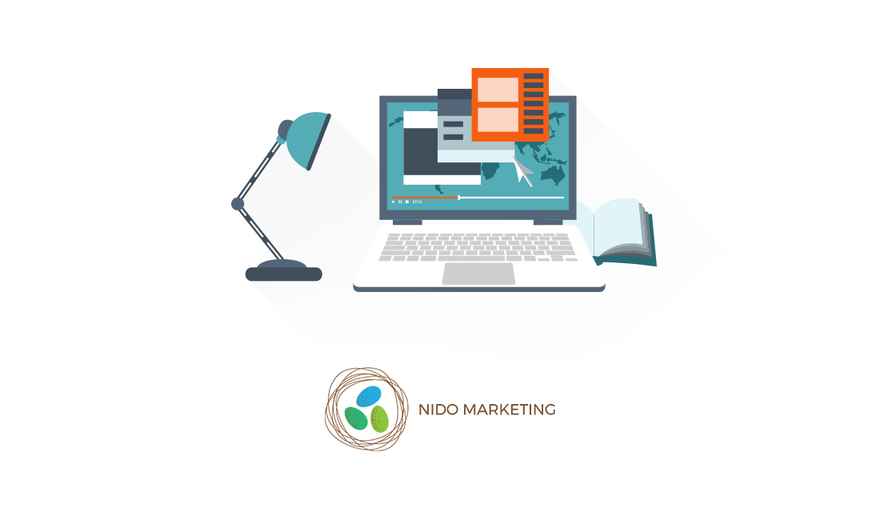
What is the very first thing a prospective parent is going to do if they’re interested in your school?
Visit your website.
This is as true for warm referrals as it is for someone who just happened to drive by.
Your website is your school’s first first impression. All too often, we tend to think of a website simply as a digital brochure—a quick and convenient way for people to find your phone number or address.
The problem with this thinking is it diminishes the critical role your website plays in the success of your Montessori school.
So let’s think about it this way instead:
Your website is an extension of your school and can be one of your most powerful marketing assets.
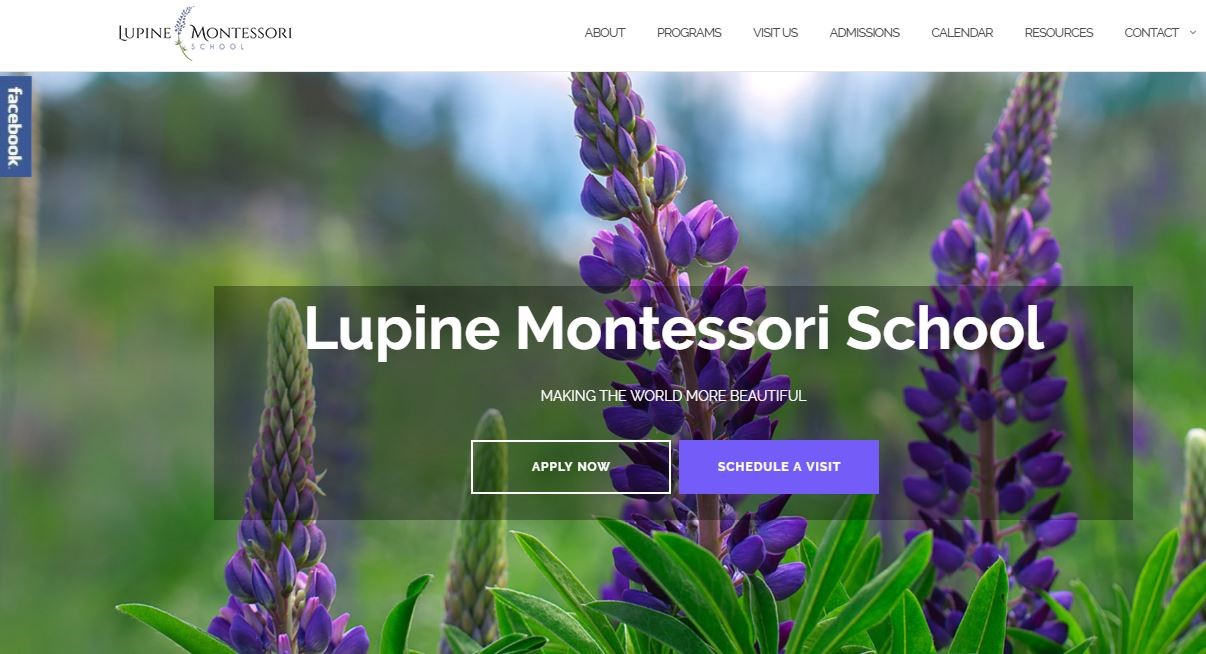
The best part is that it doesn’t need to be difficult! There are some very simple additions you can make to your site that will have a profound impact.
You may already be doing a lot of this. If so, good for you! For anything you might be missing, don’t despair or feel overwhelmed.
Instead of attempting a major website overhaul, which can be expensive, time-consuming, and stressful, I recommend picking the thing that looks the easiest and starting there. If you make one small change a week (or a month!) you’ll have knocked out this entire list before you know it.
So, without further ado, I’ve divided the top 16 must-haves for every Montessori school website into three simple categories: Engagement, Content, and Technical Basics.
ENGAGEMENT:
- The ability for parents to schedule tours online
If you have been a Nido Marketing member for more than 5 minutes then you already know this is one of our favorite drums to beat. Why? Because it works!
This has been one of the most impactful website changes for Bergamo Schools, our flagship marketing program.
We strongly recommend using a free tool (like Calendly.com) in order to allow parents to schedule a tour of your school online.
Calendly integrates with your existing Google Calendar to ensure you are only offering times that are available so you don’t end up double-booked.
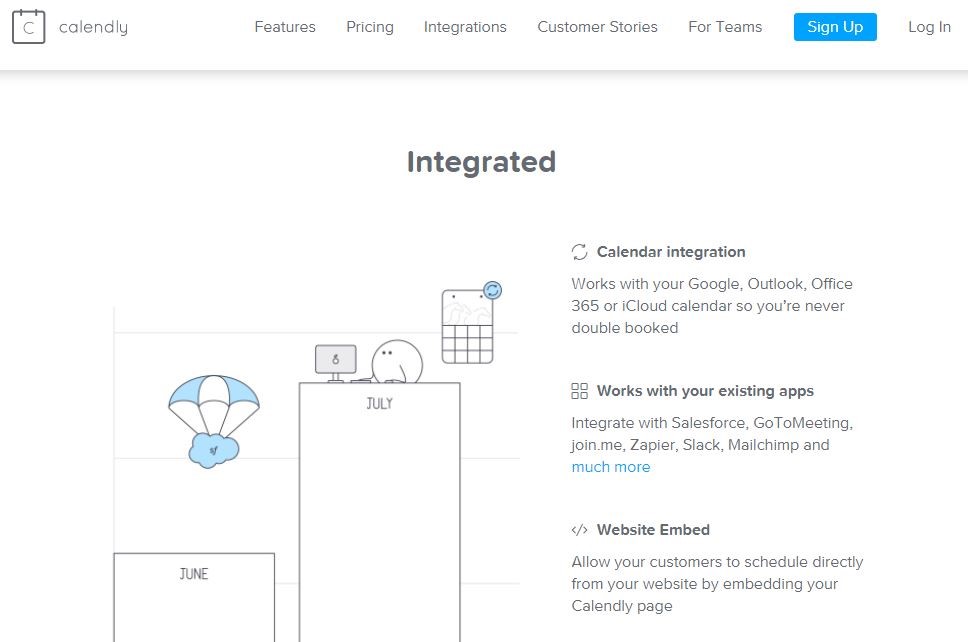
Calendly also has a host of settings that let you define when tours are available, for how long, and on what days.
When someone schedules a tour, Calendly will alert you and your staff immediately. It will also send the prospective parent an email confirmation with a calendar invite.
Better yet, you can set up Calendly to send a follow-up email before the tour date!
We actually have an entire blog dedicated solely to the magic that is Calendly.
We also have a completely FREE course on how to use Calendly for your school. Sign up for our free membership to get immediate access.
- Gated tuition information as a lead magnet
To “gate” something on your website means to make it so that a user needs to fill out a form in order to access the information. The form is the “gate” through which users must travel in order to get to where they want to go.
We strongly recommend making your school’s tuition information available online for prospective parents to access—just not at first glance. (You can read more about that here.)
Even though the vast majority of parents who are conducting their initial research aren’t yet ready to speak with you directly, this won’t stop them from making decisions.
You don’t want parents to discard your school as an option because it “looks too expensive” or because they simply assume they can’t afford a higher-end program like Montessori.
And yet, at the same time, it’s helpful for you to qualify prospective parents so you’re not filling up your tour queue only to find out that the cost of your program is prohibitive to your prospects.
Making tuition information gated content helps solve all of these problems. In addition, it has proven to be the most effective “lead magnet” for Bergamo Schools.
A lead magnet is a piece of content or information that you offer to a website user in exchange for their email address. This allows you to add them to your email list and send them quality and relevant information you know they’ll be interested in.
When parents visit the Bergamo Schools website, throughout their browsing experience they are offered the ability to view tuition information via very subtle but clear calls to action like the one below.
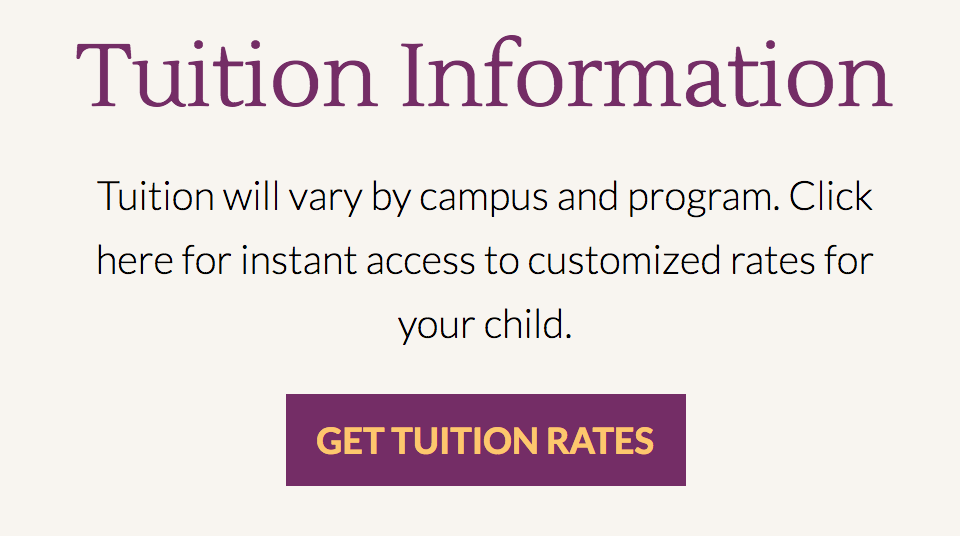
When a parent is interested, they click on the GET TUITION RATES button and a form pops up that asks them to define what information they’re interested in specifically.
Here’s what that form looks like:
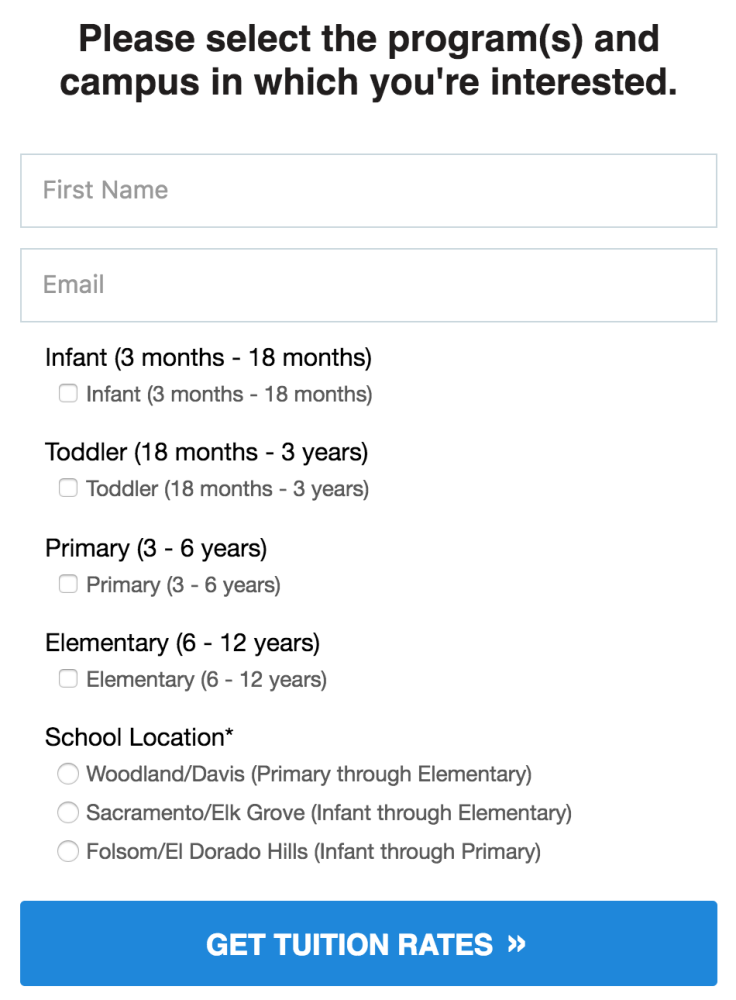
After filling out the form, the parent receives a confirmation message that thanks them for their interest and directs them to check their email inbox.
Voilà! Now they have instantly received the tuition information they requested, and Bergamo Schools has their email address which allows for targeted follow-up.
At this point I strongly recommend automatically placing this new subscriber into an email nurture sequence.
An email nurture sequence is a series of emails, spread out over a number of days, weeks, or even months, that slowly drips extremely high-value content on your new subscriber.
This is an excellent way of keeping your school top of mind and establishing yourself as a thought leader.
Pro Tip: Nido subscribers have access to a pre-written email nurture sequence in our Resources section in the Members area!
If you are interested in gating your tuition information, we also have a course in the Nido Marketing Members area on how to build a lead magnet delivery mechanism.
- Location information with Google Maps integration
It’s important to have your location very clearly listed on your website. You also want to make sure your address is included in a way that allows for it to be utilized in the proper manner.
Google will actually cross-reference the address you have listed on your website with the address you have listed in other areas of the internet (Yelp, Dex, Google Places, etc.), so it’s important that your school’s address is something Google can actually see.
This isn’t as complicated as it sounds. It just means that you need to ensure the address is clearly written out in plain text on the page and not as part of an image.
We have seen some schools getting into the habit of including their contact information in a type of letterhead format. While this might look pretty, what you’re doing is actually inhibiting Google’s bots from being able to identify your address.
Internet bots, sometimes called spiders, “crawl” through large amounts of web content to help searchers find what they are looking for.
How can you tell if your address information is in the right format? Try to copy and paste it from your website. If you can copy the text and paste it elsewhere, you are in good shape! If you can’t, I strongly recommend changing that immediately.
I also recommend making sure you’re embedding an active Google Maps widget on your site to ensure Google is indexing the correct address.
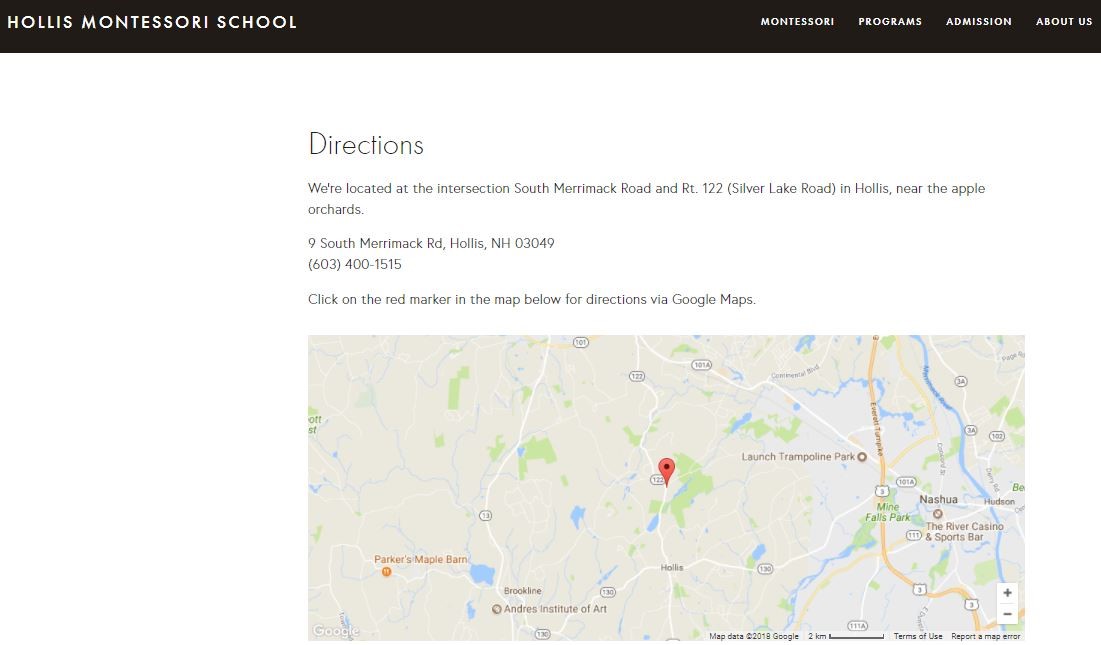
This is extremely easy to do and allows your mobile users to instantly query directions if they’re looking for you on the go. Google provides details on how that can be done.
- Social media buttons
Chances are high that you already have a social presence of some kind. For Montessori schools, we believe strongly that the Facebook ecosystem is the most relevant and the most important to cultivate.
That can mean a Facebook Business page, an Instagram account, or possibly even both.
If you don’t have a social presence, it’s time to start.
And—you guessed it!—we have a course for that. If you’re a Nido Marketing member, head over to the Members area for our course on building your Facebook Business page.
Assuming you already have that in place, it’s time to make sure parents and prospects can find you! The easiest way to do this is to include links to your social profiles on your website. These can be included in your content, on your Contact page, and even in the footer of your website.
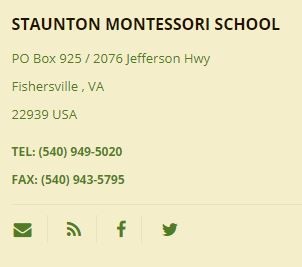
This offers parents a constant reminder that they can engage with you on your available social channels. This is exceptionally helpful for establishing yourself as a thought leader to your prospects.
Remember, you don’t need to build out a profile on every single social network. Don’t overextend yourself. It’s better to have one or two profiles that are well kept than a dozen that are never updated.
My personal preference for social profiles for Montessori schools, in order of importance, is:
- YouTube
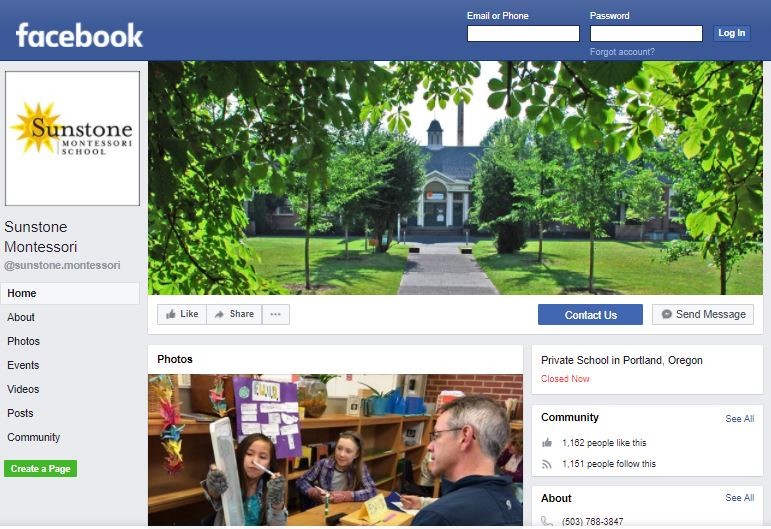
Remember, only build profiles that you know you’re capable of managing:
- Facebook requires ongoing updates of information and quality content.
- Instagram is very photo heavy and will need you to capture imagery on a regular basis.
- Pinterest is media heavy and an excellent place to gather relevant images from around the web.
- YouTube, of course, is a video sharing platform that should only be emphasized if you plan on creating a lot of original video content.
- Your school’s calendar
We’ve said your website is an extension of your school. Now it’s time to put it to work!
Adding small but powerful pieces of functionality to your website can result in it helping to streamline your processes, free up time, and support your parent base.
A great example of how this can be done is your school’s calendar. It can be difficult for parents to remember what is happening and when. Hosting your calendar online gives them a quick and easy reference point that they can return to whenever they want.
In addition, it becomes a marketing tool of sorts because prospects have the opportunity to see all of the awesome things your school does on a regular basis as well as the support systems you’re making available to your parents.
If you prefer, you can have a public and a private calendar and only make the private calendar accessible to parents in the Parents area (which we’ll talk about next).
The best part? It’s easy!
If you’re using a Google calendar (which is what we recommend to all Montessori schools), embedding your calendar on your website only takes a few minutes.
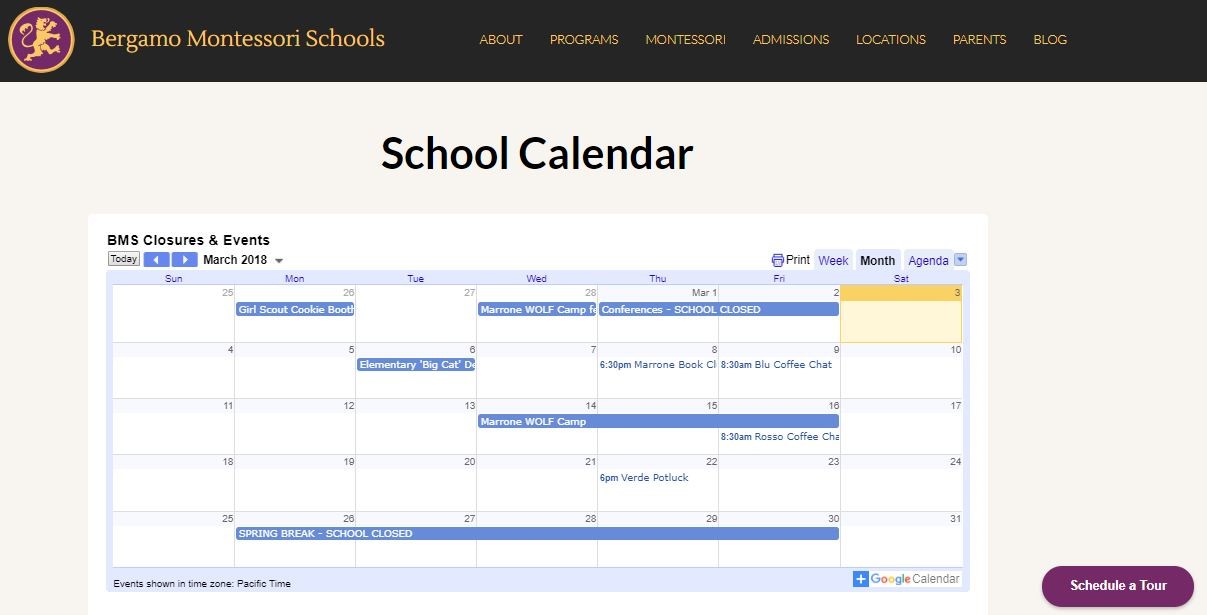
Second Plane Members and above: Nido Marketing offers a course in our Members area that walks you through exactly how to embed your school calendar on your website!
Remember, you can do this with as many calendars as you’d like. That means you can have a calendar specifically for your internal events so your staff can stay up to date. There could also be a calendar for your board of directors.
Google allows for an unlimited number of calendars and they’re all managed from the same dashboard, making it extremely easy for you to create events and then dictate which embedded version displays which events.
Another very cool piece of functionality allowed by embedded calendars is the fact that people can subscribe to your calendar.
If they’re already using a Google calendar, they can choose to have your calendar added to their calendar view so they see all of the events.
Alternatively, they can cherry-pick various events and only add the ones that apply specifically to them.
This quick and easy step will increase your efficiency, showcase to new prospects all of the benefits your school provides, and help you keep parents engaged.
After you have embedded the calendar, there’s no additional work required. You simply manage your events the same way you would have otherwise and they’re made visible according to how you categorize them.
Click here to see all of Bergamo’s online calendars.
- A place for parents
For as much as your school’s website is a place to attract and engage with prospective parents, it is also a place to connect with your existing parents.
Montessori is about far more than simply providing a place for childhood education; it’s about cultivating a community based on the values inherent in Montessori culture.
Providing a place on your website where parents can ask questions and find resources and information relevant to their child’s program is an important step toward building that community.
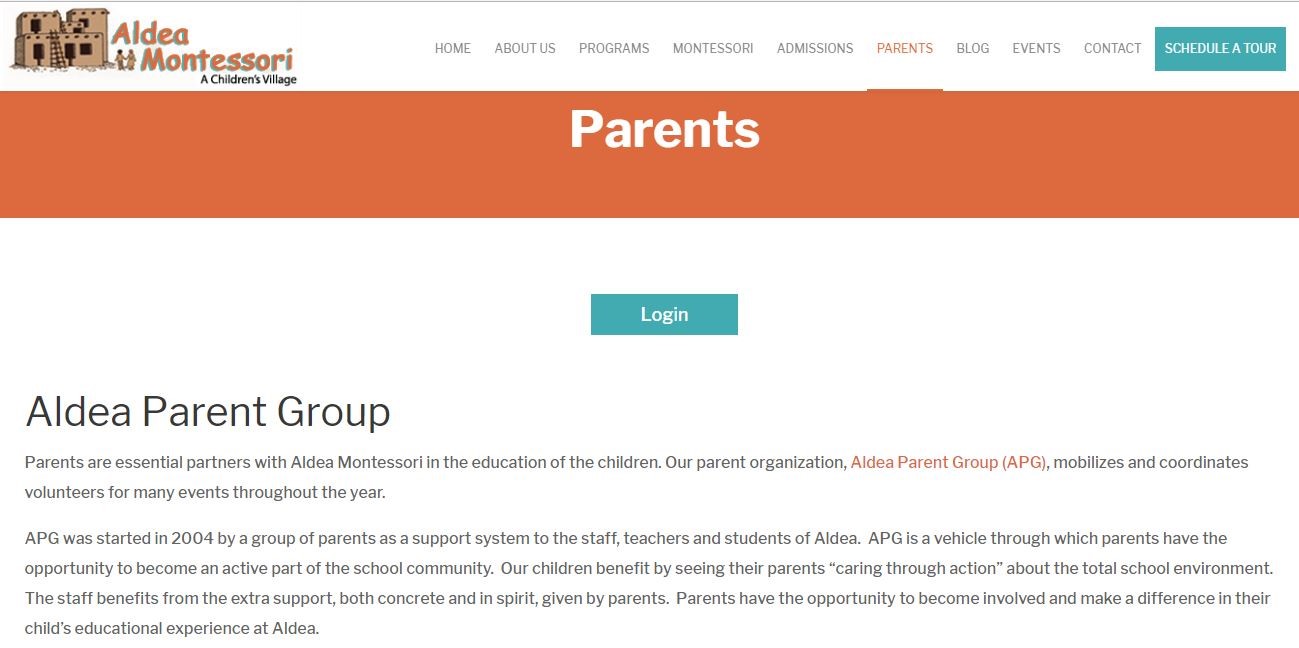
Here are some ideas of things that may be included on your Parents page:
- Director/teacher contact information
- Calendar of events
- Downloadable forms/permission slips (e.g. medication, emergency contact)
- Downloadable information packets, parent handbook, etc.
- Details and instructions for new offerings (e.g. hot lunches)
This is also a great place for new and noteworthy content you want to highlight, such as a new blog or an article of interest.
CONTENT:
- Program information
Parents are going to want the ability to contextualize your school against their specific needs. Said another way, they want to know what it is you’re offering their child specifically.
Most schools do an adequate job of at least outlining the age ranges they accept. However, it’s extremely important that you provide details around each of your specific programs.
Take the time to explain how each program is different, how your approach to that specific program is unique, and what parents can expect to see and experience.
There’s a very logical sequence to every buying cycle, regardless of the product or service someone is shopping for. In terms of Montessori education, the logical sequence is embedded very strongly in allowing parents to educate themselves on the options.
It’s tempting to simply rely heavily on the “you have to see it to understand” type of narrative and just ask parents to schedule tours. However, this puts you at a disadvantage because so many parents are simply not ready to engage on that level yet.
However, they are on your website. They have indicated by being there that they are interested in reading, learning, and understanding more about you and your school.
It’s time to give them what they want.
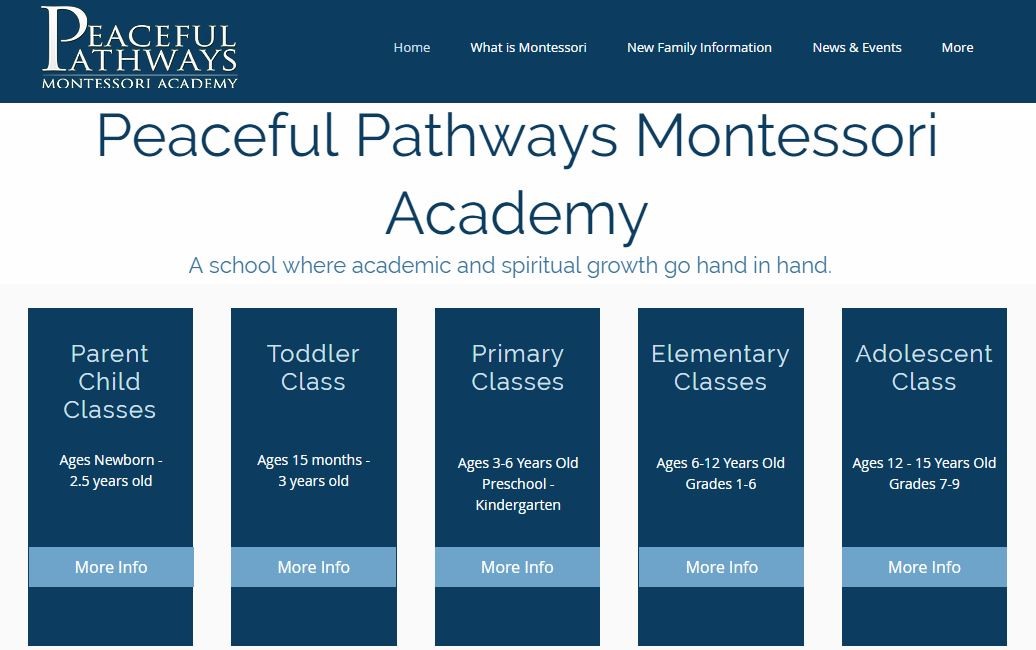
Allowing parents to learn more about your specific programs positions you to earn their trust and allows them to continue their journey through the buying cycle uninterrupted.
This means you’re going to keep them engaged long after another school that chooses not to provide this additional content.
You don’t need any more than one page dedicated to each program. However, I do recommend investing some time and effort into that one page! When a parent lands here, they’re offering you strong buying signals. That means you want to put your best foot forward.
For your reference, and to help get your creative juices flowing, here are the program-specific pages on Bergamo’s website:
- Montessori-specific content
It’s important that we don’t make any assumptions about what our potential families do and don’t know about Montessori education. Just because they’re looking into Montessori education doesn’t mean they have been properly educated on the model.
This is especially important when working toward only attracting mission-appropriate families. By helping people understand the broad strokes of Montessori and what sets us apart, you’re positioning them to qualify themselves, which can save everyone a lot of time.
In addition, the Montessori Method can mean something different to you than it does to another school. Because anyone can claim to be a Montessori school it is important that you plant your flag in terms of exactly what that means for your school.
This doesn’t need to be an inordinate amount of content. We aren’t trying to train our parents on how to be Montessorians; we’re simply putting forth the core values and principles that we espouse.
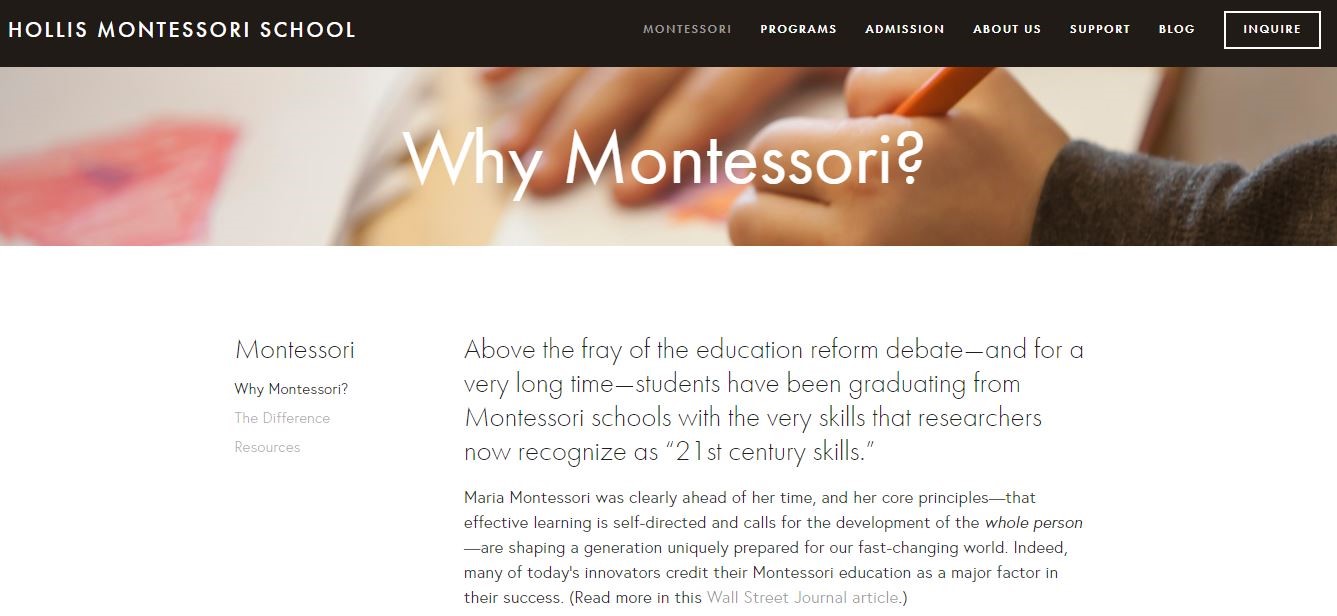
I’m especially fond of comparisons between Montessori education and traditional education. This not only helps to outline the benefits of the Montessori model, but it also helps to prepare parents who might not have a strong understanding of the Montessori approach.
You don’t want parents scheduling tours without having reasonable expectations as to what your school is and what it provides. Ensuring that you’re properly articulating what the Montessori model is and how it’s deployed within your school will help mitigate this risk.
Second Plane Members and above: There is a wealth of content available to you in our Resources section in the Members area. Articles such as, “A common sense guide to choosing a Montessori school” (and many, many others) are all available for you to use on your website.
- Don’t forget to tell them about YOU
Every Montessori school is unique! That’s one of the many things that make the Montessori model so special. Don’t forget to spend time building content that tells parents specifically about your school.
(Yes! It’s okay to toot your own horn! Click here to learn why it’s not just okay but essential.)
In our experience, your “About” page can be one of the most visited pages on your website. Prospects are extremely interested in learning what sets you apart from all of the other schools that are available to them.
How you choose to do this is completely up to you. However, here are a few ideas that will hopefully provide a little inspiration. Please keep in mind that you don’t need to do all of these things! Pick and choose as you feel appropriate.
- Your story or history
I’d be willing to bet a whole pocket full of little pink cubes that there’s a great story behind the founding and growth of your school. Don’t be afraid to tell that story!
You’re building a relationship with people online (that’s what digital marketing is, by the way: relationship building). One of the most important facets of building a relationship with someone is learning where they come from.
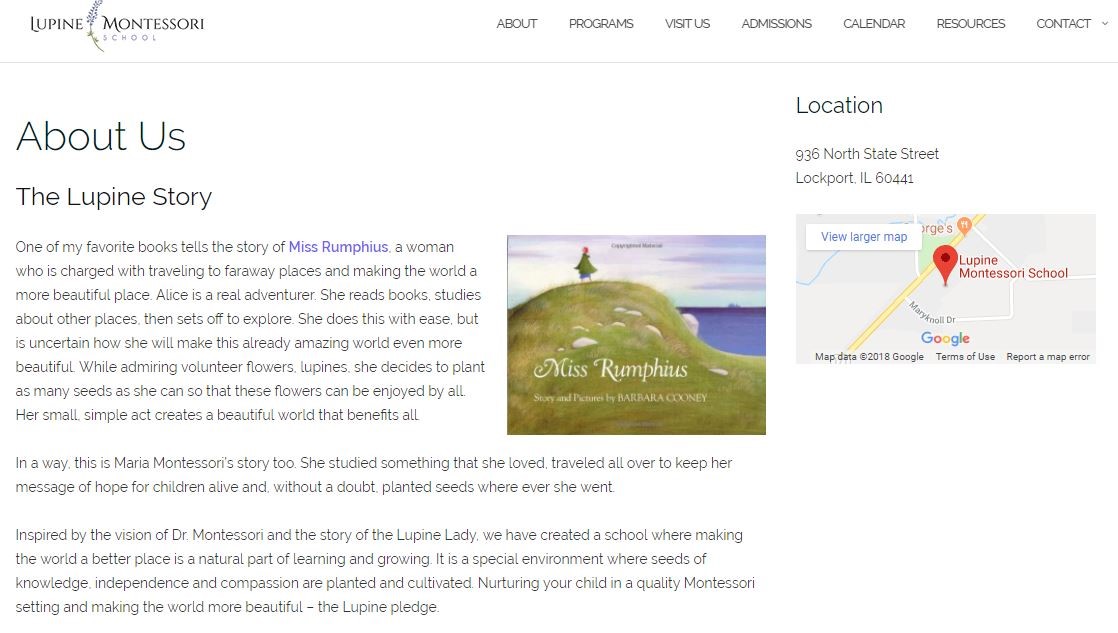
- Mission statement
If you have spent the time preparing a mission statement, please don’t let it waste away on the corkboard in your office! This can be a central part of your “About” section.
Not only should you share your mission statement, but I think it can be a great idea to offer some background and context as to how you arrived there.
- Staff profiles
As a parent, one of the single biggest interests I had when choosing a Montessori school was meeting the people with whom I would be entrusting the safety of my son.
Having the opportunity to learn more about you and your staff allows parents to begin building that level of comfort with you even before you have had the chance to meet.

Being able to see your face and hear more about your personal story can do wonders in terms of setting people at ease with one of the most important decisions they can make as parents.
- Photos
People want to see your school! This can be a daunting task, but there is no reason to be overwhelmed by it.
One of the benefits that the social media age has yielded is the fact that people are used to (and maybe even respond better to) casual photography in lieu of professional photographs.
What I’m saying is this: You don’t need to spend a bundle to have a professional photographer come out and take pictures of your school. If you can afford to do so, great! It’s a sound investment.
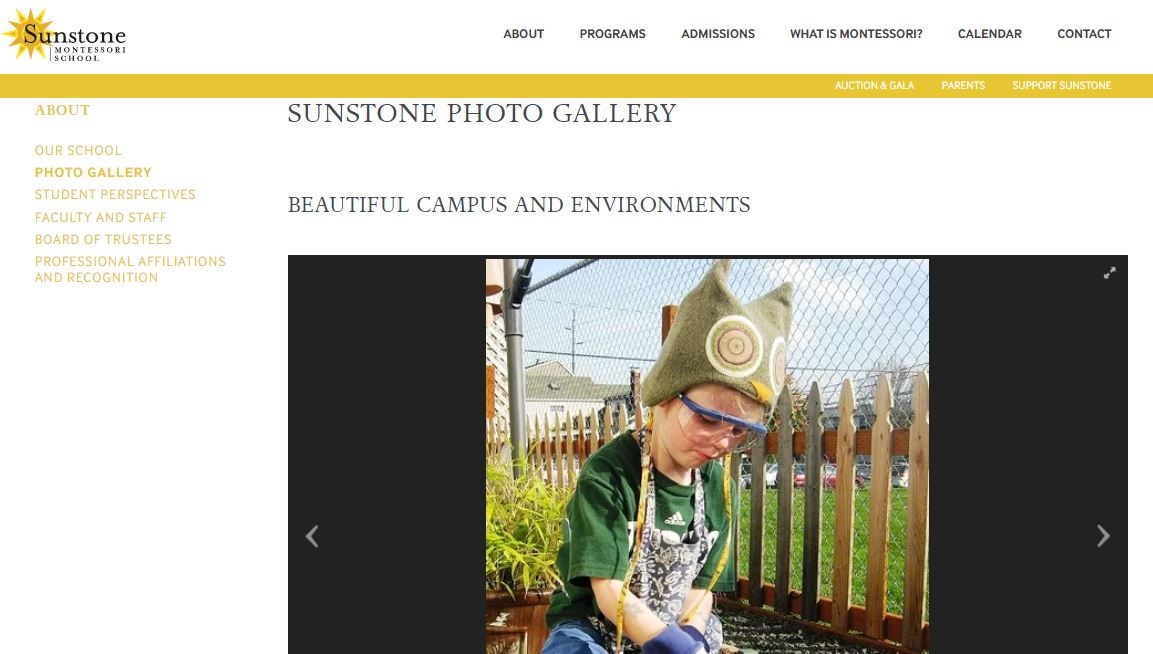
However, your recent-model iPhone can yield crisp, high-resolution imagery that’s perfect for your website. You or a member of your staff can easily build a fine gallery of images.
While I wouldn’t necessarily use these casual photos for your home page banner image, I am of the strong opinion that they are much better than not providing people a glimpse into your school as they traverse your website.
- Frequently Asked Questions (FAQs)
The FAQs page is something that often gets overlooked but that is actually an incredibly important facet of your website—for a few reasons.
First, your FAQs page can save you a lot of time by answering many of the questions you get asked most often about your school.
This cuts down on the amount of time you and your staff are required to spend on the phone or answering emails, and we all know freeing up a little extra time in your day feels like winning the lottery for busy Montessorians!
Second, a well-thought-out FAQs page can actually improve your search engine ranking if you think about the questions (and relevant keywords) people are most likely to ask or search for when looking for information about Montessori schools.
Click here to see Bergamo’s main FAQs page.
And finally, a good FAQs page helps to establish you as a thought leader within the Montessori community and even beyond that, within the larger context of early childhood education.
This can do wonders for your conversion rate, as parents are more likely to enroll their kids in a school that is able to provide thoughtful, informative answers to their questions.
When creating the content for your FAQs page, remember to keep it on the shorter side. Parents are likely just looking for a clear and concise answer, and if they need a more in-depth response your contact information should be close by.
You may also want to consider creating multiple FAQs pages or sections based on specific categories (e.g., Montessori FAQs, Programs FAQs, Admissions FAQs).
One more thing: make sure your FAQs page includes an easily visible option for parents to ask questions you may have missed or to get more information about specific topics.
This can be as simple as a form with a place for their name, email address, and question or concern. Here is an example:
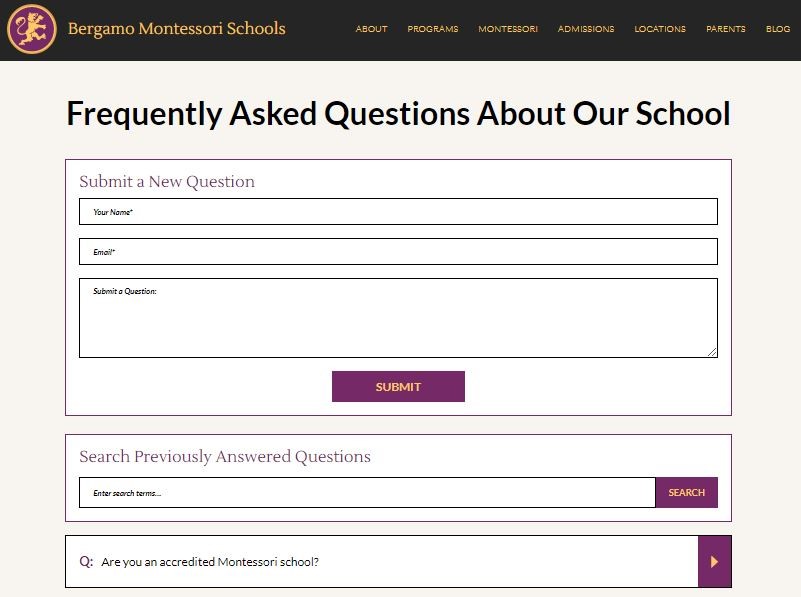
- Testimonials (social proof)
Before you buy a product online, you always read the customer reviews to see what other people had to say about it.
Guess what? The same goes for your Montessori school.
Social proof is easily one of the most powerful reasons people take action.
People rely on other people for validation, and this is especially true of parents who are trying to choose the best school for their child.
The key for your Montessori school is to showcase testimonials that relate to your website visitor—those that are genuine and from real people.
Adding testimonials can be as simple as sprinkling a few parent statements on your home page and throughout your website or you can choose to create a dedicated Testimonials page like the one below.
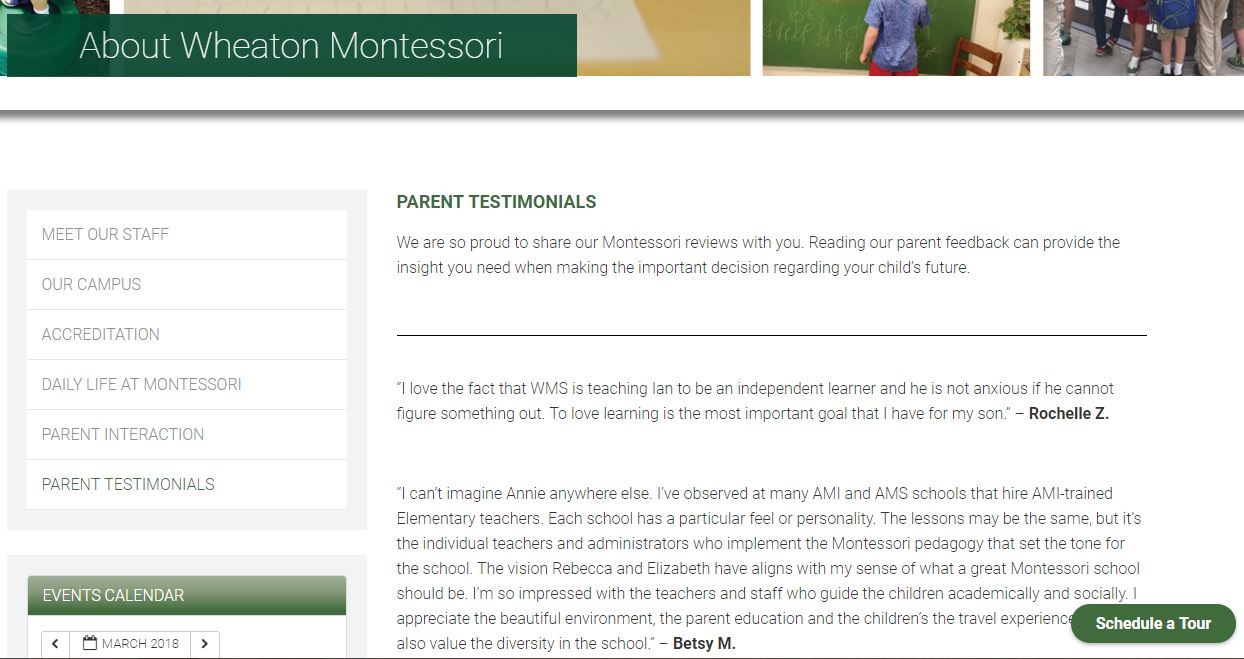
The important thing to remember is to always be asking for testimonials. Think about simple techniques such as attaching a quick message to your email signature that says something like, “Love our Montessori school? Tell us why!”
Other methods for requesting feedback include sending an email or including a call to action on your website that links to a form parents can easily fill out and submit.
The great thing you’ll find is that most parents are more than happy to say nice things about your school! All you have to do is ask.
Once you begin to build a collection of really great testimonials, you can start to use them across other elements of your digital marketing campaign such as in your ads and social media posts.
- Blog
It’s pretty interesting that what started out as an online journaling tool is now one of the best ways to offer informative and relevant content on the web.
Blogs are one of the most critical pieces of your school’s online marketing strategy.
Why?
Because, like a lot of other marketing tools, your blog can help you stand out as a thought leader in the Montessori community.
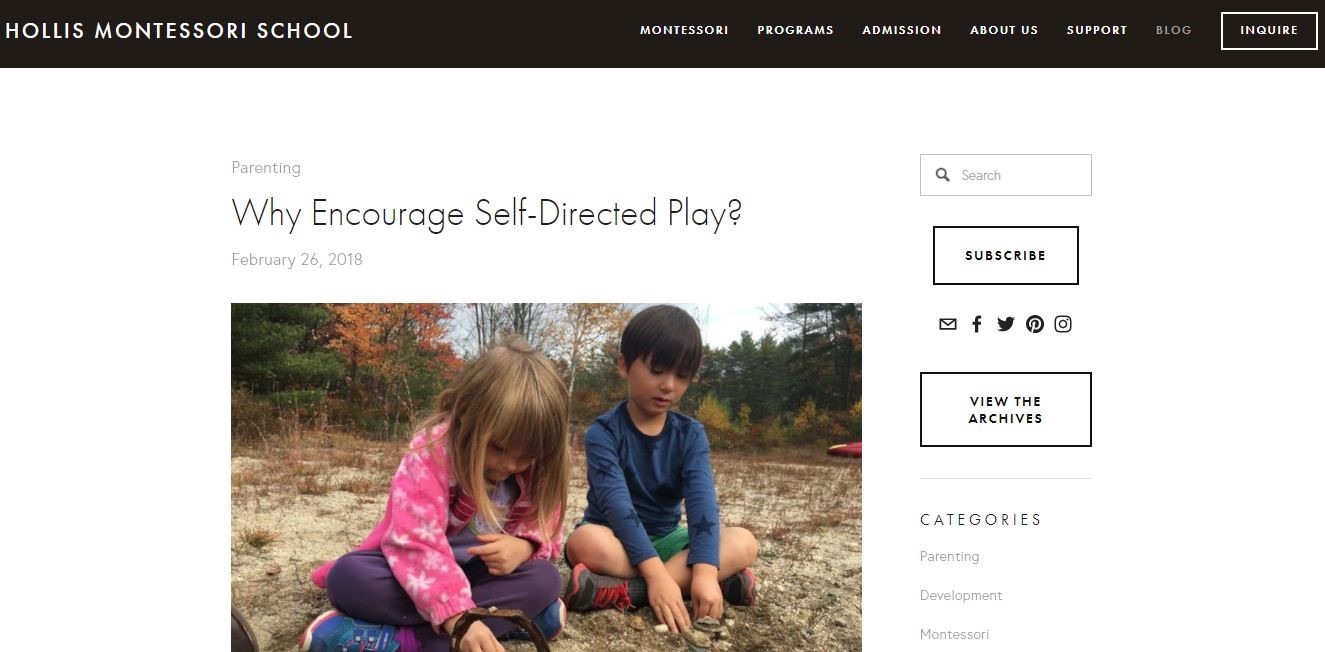
Blog content that resonates with your readers helps to build trust and encourages your existing parents as well as prospective parents to become subscribers and continue to benefit from the information you’re providing.
Which brings me to my next point:
It’s critical that you keep your blog content fresh!
This is easier than you might think, thanks to free tools like Google Alerts that can automatically search for Montessori-related topics and send you an email notification when new headlines pop up.
Other blog content ideas include school events, tips and tools for parents, teacher spotlights, and even blogs created from your FAQs list.
Here is an example of a blog written by Nido Marketing for Bergamo Montessori Schools that went “viral” (which means it spread rapidly thanks to social sharing):
https://www.bergamoschools.com/montessori-basics-montessori-work-period/
Because of the power of social sharing, viral content leads to more views by more prospective parents. This can boost your school’s organic search rankings and lead to more scheduled tours and, ultimately, increased enrollment.
Add to your blog content as often as possible, but always look to quality over quantity.
If you can post a new blog once a week, that’s fantastic. If not, it’s fine to hold off until you have something beneficial to offer. (Just try not to wait too long in between posting, as readers will be looking for new content.)
Your blog is also helpful for driving traffic to your website.
Every time you post a new blog, be sure to promote it on all of your social media platforms to steer visitors to your site.
You can also include links within your blogs to landing pages where prospective parents can take the next step on their journey toward enrolling their child in your school, such as scheduling a tour.
(Click here to learn why landing pages are crucial for your Montessori marketing.)
And last but definitely not least, continually creating new blog content will boost your search ranking naturally by increasing the use of keywords and key phrases on your website.
And here, again, quality is far more important than quantity.
In the past, it was easy to post a large amount of low-quality website content filled with repetitive keywords in an attempt to rank better in search results.
However, search engines like Google have gotten smarter and are cracking down on the practice of “keyword stuffing”.
When creating blogs for your Montessori school, focus on content that provides value to your readers. Use keywords only when they are appropriate and work with the natural flow of your content.
Interested in learning more about content marketing for your Montessori school? Check out our blog: How to Plan Your Content for the Year.
Second Plane Members and above: Nido Marketing offers a course on creating a content schedule for your school. You’ll find it in our Members area!
TECHNICAL BASICS:
- Mobile responsiveness
When was the last time you checked out how your school’s website looks on your phone?
Now might be a good time to try it.
Mobile devices recently surpassed desktop for internet use, meaning more parents are using their smartphones and tablets when they want to research things like the best school for their kids.
That means if your site comes up short in terms of mobile viewing, you could be missing out on a huge opportunity to engage with more potential parents.

In our increasingly digital world, it’s important to connect with your audience where you’re most likely to find them—and to do it in a way that makes their user experience faster and easier.
Optimizing your website for both smartphone and tablet viewing helps eliminate usability issues that may affect whether or not your site is mobile-friendly.
A few tips?
- Keep it simple! Mobile users don’t expect to see your full website, but be sure to include your core content, primary calls to action, and a strong conversion component.
- Use the right technology. “Browser side” technology such as JavaScript enables a faster and more responsive user experience by allowing functions to take place on the browser end instead of on the server.
- Keep your user’s needs in mind. In their initial search, most parents are focused on the basics: your programs, admission information, a bit of background about your school. Make this information easily available, along with simple buttons to find out more or schedule a tour.
- Always include a link to your full website in case parents would like the opportunity to fully engage with your application.
- Speed
Nobody likes a website that takes a looooooooooong time to load. Am I right?
My point is that it really, really matters how quickly content loads on your site—for two big reasons.
First, busy parents aren’t going to want to wait around for a page to load, especially not today when people are used to everything being instantaneous.

Second, slow site speed—and subsequently slow page speed—could negatively affect your search result rankings. (Google just recently announced that slow load speed will be a ranking factor.)
On a larger scale, slow load speed can impact consumer engagement, which can have negative consequences for your Montessori school.
A parent who had a bad mobile viewing experience may tell another parent, who in turn may tell another parent, and so on. This can lead to reduced trust in your school.
When trust is diminished, it often means a lower conversion rate, which means fewer tours scheduled and fewer enrollments.
It may sound like a dismal exaggeration, but really there is nothing speed doesn’t impact for your school’s website.
Bottom line: it’s worth the time it takes to make your website mobile friendly.
- Security (SSL)
When conducting business online, you should always make sure your website is secure.
One of the best ways to do that is with SSL encryption technology.
SSL (secure sockets layer) technology protects information that is shared over the internet by taking plain text and turning it into something only the user and the website can understand. This process is called encryption.
When an SSL certificate is installed on your site, the “http” application protocol will change to “https,” with the “s” indicating the site is secure.
Seeing that little padlock symbol helps to establish trust and lets parents know their login information, personal data, credit card numbers and other information will be protected.
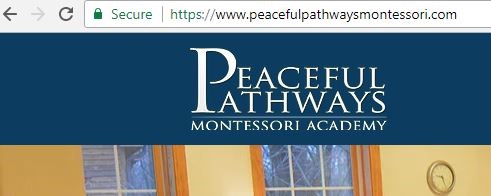
And speaking of trust … it’s a big factor when it comes to increasing your conversion rates!
When prospective parents see your site is secure, they are more likely to think of your school as a reputable business and take that next step toward getting more information.
One more thing: did you know having a secure site can boost your search ranking? According to Google, websites with an SSL certificate will now rank slightly higher than those without.
- The right platform
Every good website starts with a good foundation.
Depending upon your available resources, Nido Marketing recommends either WordPress or Wix.
In our opinion, WordPress is the gold standard.
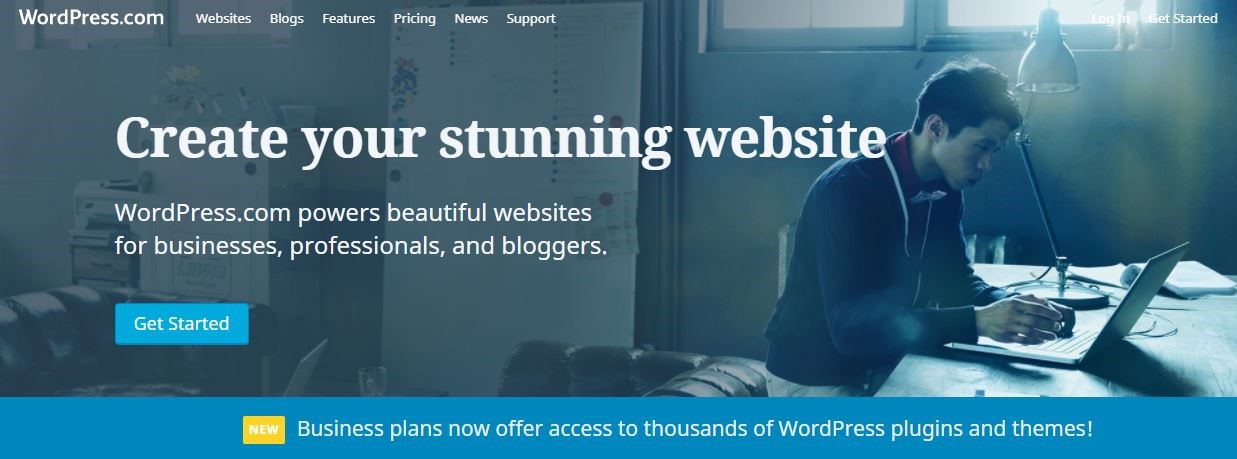
Here are a few reasons why we love it:
- WordPress has been around a while, which means they’ve had plenty of time to work out the kinks and make it incredibly user friendly.
- Because it started out as a blogging tool, WordPress makes it easy to manage both your blog and your website from the same platform.
- WordPress has tons of themes to choose from, many of which are free and already optimized for mobile.
- If you know a thing or two about plugins, WordPress lets you quickly make updates to your site and expand your functionality.
A plugin is a software component that allows you to add new features and customize your website.
However, the thing we tell our Montessori partners is this:
If you have someone to help you with the technical stuff, go with WordPress. If you’re going it alone without the benefit of a personal geek squad, Wix may be the better option.
Wix is website builder made for people who have never built a website.
Really! The user-friendly platform features lots of drag-and-drop components that make it simple to design, build, and publish a website even if you aren’t particularly tech-savvy.
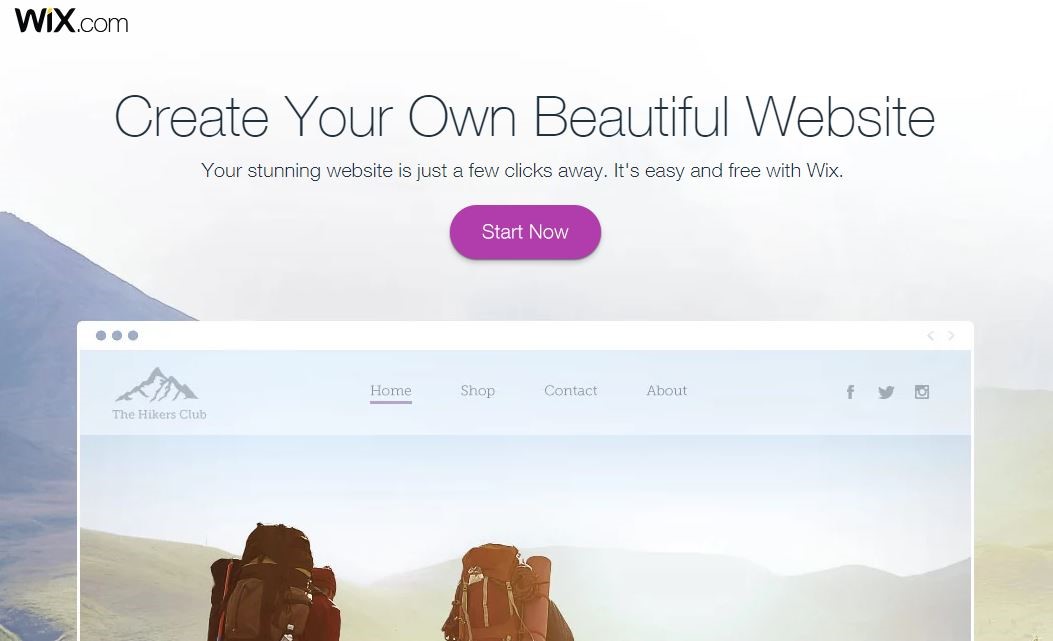
Plus, with Wix you never have to worry about plugins because they take care of all of the features and functionality on their end.
Not only that, but the Wix development team handles all site maintenance and automatically deploys updates so you don’t have to worry about it.
And, if you ever do run into problems, they have excellent technical support.
So there you have it!
If you’ve made it all the way to the end of this list and have even a few of these components covered, you’re off to a great start.
If, however, you got here and now feel queasy thinking about all the things your website isn’t, don’t panic. That’s what we’re here for.
Contact Nido Marketing today and get help from the only digital marketing agency founded by Montessorians for Montessorians.
Not a member yet?
Get started for free and join an online community of other dedicated Montessorians looking to transform their online presence with the help of cutting-edge marketing tools and strategies.

0 comments
Leave a comment